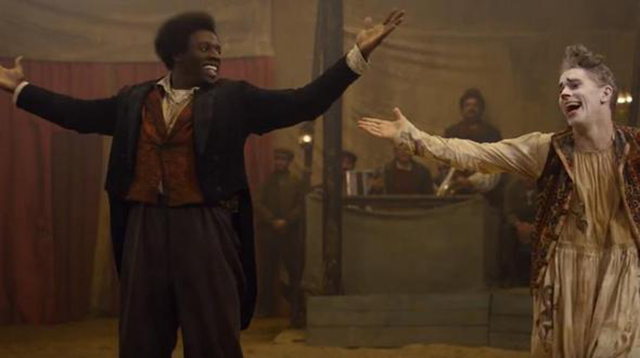Charting the rise and fall of France’s first famous black clown, CHOCOLAT brings all the flamboyant wonder of the Belle Époque era to the big screen, while presenting a deep insight into the struggles of the eponymous character as he fights to simply live his life in an unforgiving, racially abusive society that detests his ambition and adores his humiliation.
When we first meet Chocolat (Portrayed to perfection by The Intouchables star Omar Sy) he is bounding around the circus ring in a leopard-skin leotard, sneering and snarling at the crowd, which gasp and scream at his antics. Going by the name Kananga, and with a chimpanzee as a sidekick, he is played off by the circus as a primitive beast. Enter George Foottit (circus-stage star James Thiérrée channelling his grandfather, Charlie Chaplin) a slapstick clown a little past his prime who sees an opportunity in Kananga. Together, they form the partnership of Foottit and Chocolat, pairing the sophisticated White Clown with the clumsy Auguste, much to the joy of audiences.
The impressively choreographed routines are easily the most immersive part of the film.
It’s when the pair of clowns move their act to a swanky theatre in Paris that CHOCOLAT really gets going. Dizzying camerawork matched with Gabriel Yared’s jaunty, delightful score make watching the impressively choreographed routines easily the most immersive part of the film. Thiérrée’s ancestry is apparent as he tumbles and pratfalls with nuanced grace and spot-on comic timing, while Sy keeps pace with ease — the frenetic chemistry between the two could have easily carried CHOCOLAT by itself.
Unfortunately, clowns weren’t the only thing rampant in turn of the century Paris.
Chocolat first begins to understand the entrenched racism of his industry when he is incarcerated for being in the country illegally. In prison, his cellmate Victor (Alex Descas) opens his eyes to the humiliation that Chocolat subjects himself to on a nightly basis. He explains that the white people in the audience like to see a black man bossed and kicked about, and like it even more when he comes up smiling. When Chocolat walks out of the prison a few days later, the usually happy-go-lucky clown finds himself in a much darker city than before.
Zem is telling the story of this pioneer of pantomime, warts and all.
Here is where the true power of CHOCOLAT lies. Beneath the glitz and glamour is a city that simply refuses to accept a black man succeeding. Be it white people sneering at his expensive wardrobe, or Foottit earning twice as much as his supposed equal, it’s all subtle and presented with maturity and respect by director Roschdy Zem, himself a highly-regarded actor. Whether Chocolat is smiling at a pretty woman, or suffering another kick to the behind from his partner, it’s clear through Sy’s mastery of micro expressions that he no longer sees the funny side; all he sees is a world of people who can’t see past the colour of his skin.
It says a lot, both about the film and society itself, that the events and interactions in CHOCOLAT are instantly relatable over a century later. That, in the end, is the film’s greatest triumph. Zem is telling the story of this pioneer of pantomime, warts and all. There is no preaching in the subtext, and certainly no soapbox rallies for justice against racism. There is no need for it. Presented here is no more and no less than is needed to get people talking.
Chocolat ended up dying in poverty, but thanks to this film, his legacy will live on.
httpvh://www.youtube.com/watch?v=oS_VOZHAMl0




One thought on “Chocolat”
Comments are closed.